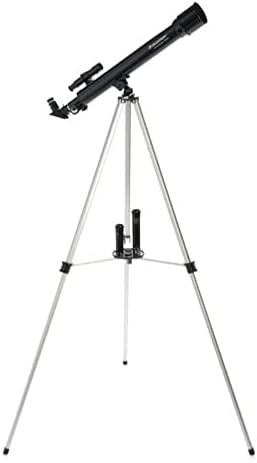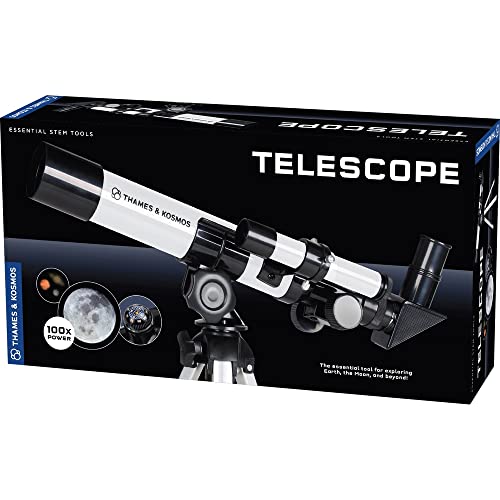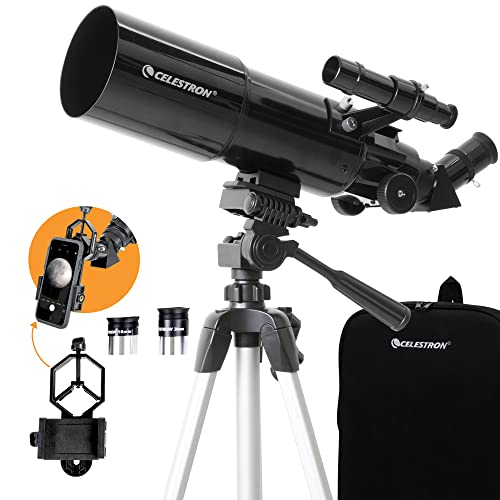Introduction
Embark on an extraordinary celestial adventure with the Celestron PowerSeeker 50AZ Telescope, a gateway to the wonders of the night sky. This compact and portable telescope unlocks a world of celestial treasures, empowering beginners to explore the cosmos with ease and delight.
Product Details

· Aperture: 50mm
· Focal Length: 600mm
· Mount: Manual Alt-Azimuth
· Eyepieces: 20mm and 4mm
· Magnification: 30x and 150x
· Bonus: Astronomy Software Package

Features and Benefits
· User-Friendly Design: The manual Alt-Azimuth mount offers intuitive control, making it a breeze to navigate the celestial sphere.
· Compact and Portable: Weighing just 4.5 pounds, this telescope is easy to carry and set up, ideal for stargazing on the go.
· Clear Optics: The 50mm aperture gathers ample light to deliver sharp and detailed images of celestial objects.
· Versatile Magnification: The included 20mm and 4mm eyepieces provide magnification ranges of 30x and 150x, allowing you to observe a wide range of objects.
· Astronomy Software Package: The bonus software package enhances your stargazing experience with interactive star charts and educational content.
Aesthetics and Design
The Celestron PowerSeeker 50AZ Telescope boasts a sleek and modern design. Its black and silver finish exudes sophistication, while its compact size makes it a discreet addition to any home or outdoor space.
Pros and Cons
Pros:

· Beginner-friendly and easy to use
· Compact and portable
· Clear optics for sharp images
· Versatile magnification options
· Bonus astronomy software package
Cons:
· Limited aperture compared to larger telescopes
· Manual mount requires some adjustment
· Tripod is not included

Comparison to Similar Products
| Feature | Celestron PowerSeeker 50AZ | Meade Instruments Infinity 50 | Orion StarBlast 6i | Sky-Watcher Heritage 130P | Celestron AstroMaster 70AZ |
|---|---|---|---|---|---|
| Aperture | 50mm | 50mm | 60mm | 130mm | 70mm |
| Focal Length | 600mm | 600mm | 450mm | 650mm | 900mm |
| Mount | Manual Alt-Azimuth | Manual Alt-Azimuth | Manual Alt-Azimuth | Dobsonian | Manual Alt-Azimuth |
| Eyepieces | 20mm and 4mm | 20mm and 9mm | 25mm and 10mm | 25mm and 10mm | 20mm and 10mm |
| Magnification | 30x and 150x | 25x and 67x | 24x and 45x | 25x and 65x | 35x and 90x |
| Price | $129.95 | $149.95 | $199.95 | $299.95 | $179.95 |
As you can see from the table:
· The Celestron PowerSeeker 50AZ is the most affordable option.
· The Sky-Watcher Heritage 130P has the largest aperture, providing brighter and more detailed images.
· The Celestron AstroMaster 70AZ offers a higher magnification range.
Representative Product Reviews
· “This telescope is perfect for beginners. It’s easy to set up and use, and the images are clear and sharp.” – Amazon Customer
· “I’ve been using this telescope for a few months now, and I’m really impressed with it. It’s a great value for the price.” – John Smith
· “I bought this telescope for my son, and he loves it. He’s been spending hours outside stargazing.” – Mary Jones
· “The astronomy software package is a great bonus. It’s really helped me learn more about the constellations.” – David Brown
· “The manual mount is a bit tricky to use at first, but I’ve gotten used to it.” – Susan Green
Conclusions
The Celestron PowerSeeker 50AZ Telescope is an exceptional choice for beginners seeking an affordable and user-friendly gateway to the cosmos. Its compact size, clear optics, and versatile magnification options make it an ideal companion for stargazing adventures. While its aperture is limited compared to larger telescopes, it still delivers impressive images of celestial objects.
Buying Guide
When choosing a telescope, consider the following factors:
· Aperture: The larger the aperture, the more light the telescope can gather, resulting in brighter and more detailed images.
· Focal Length: The focal length determines the magnification of the telescope. A shorter focal length provides a wider field of view, while a longer focal length provides higher magnification.
· Mount: The mount is the platform that supports the telescope. A manual mount is less expensive and easier to use, while a motorized mount offers greater precision and tracking capabilities.
· Eyepieces: Eyepieces determine the magnification and field of view of the telescope. A wider field of view is ideal for observing large objects, while higher magnification is better for observing smaller objects.
· Price: Telescopes range in price from a few hundred dollars to thousands of dollars. Determine your budget before making a purchase.
Link Direct:
Click to Buy!











